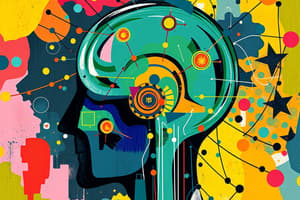Podcast
Questions and Answers
What is a primary concern regarding uncontrolled AI development?
What is a primary concern regarding uncontrolled AI development?
- Lower costs of technology development
- Improved efficiency in data processing
- Increased job opportunities
- Safety concerns and ethical dilemmas (correct)
Which aspect is emphasized as essential for ethical AI governance?
Which aspect is emphasized as essential for ethical AI governance?
- Lower development costs
- Increased market competition
- Transparency and accountability (correct)
- Rapid technological advancement
What does the moratorium on AI training seek to achieve?
What does the moratorium on AI training seek to achieve?
- Increasing competition among tech companies
- Maximizing profit from AI products
- Complete halt of AI research
- Balancing innovation with societal safety (correct)
Which group is specifically mentioned as requiring collaboration for ethical AI governance?
Which group is specifically mentioned as requiring collaboration for ethical AI governance?
What is a proposed need highlighted by Senator Blumenthal regarding AI regulation?
What is a proposed need highlighted by Senator Blumenthal regarding AI regulation?
What threat does Gary Marcus attribute to AI?
What threat does Gary Marcus attribute to AI?
What does the call for a global governance framework aim to address?
What does the call for a global governance framework aim to address?
What is highlighted as a necessary collaboration to ensure responsible AI use?
What is highlighted as a necessary collaboration to ensure responsible AI use?
What is a significant impact of biases in AI algorithms?
What is a significant impact of biases in AI algorithms?
What is the purpose of AI regulation concerning accountability?
What is the purpose of AI regulation concerning accountability?
Which risk is specifically addressed by AI regulations?
Which risk is specifically addressed by AI regulations?
How does the philosophy of technology view AI?
How does the philosophy of technology view AI?
What is one of the categories defined by the EU AI Act for AI systems?
What is one of the categories defined by the EU AI Act for AI systems?
Why is it important to manage risks associated with AI?
Why is it important to manage risks associated with AI?
Which concept illustrates the limitations imposed by metaphors like 'cyberspace' in technology?
Which concept illustrates the limitations imposed by metaphors like 'cyberspace' in technology?
What is one of the methods used for regulating AI?
What is one of the methods used for regulating AI?
What is the primary aim of the Algorithmic Accountability Act?
What is the primary aim of the Algorithmic Accountability Act?
Which of the following is an example of unacceptable AI risk?
Which of the following is an example of unacceptable AI risk?
How does the U.S. approach AI regulation differ from the EU?
How does the U.S. approach AI regulation differ from the EU?
What executive action did the Biden administration take regarding AI risks?
What executive action did the Biden administration take regarding AI risks?
Why do companies like Google and OpenAI establish internal ethical guidelines for AI?
Why do companies like Google and OpenAI establish internal ethical guidelines for AI?
What strategic focus area is concerned with addressing threats like cyberattacks?
What strategic focus area is concerned with addressing threats like cyberattacks?
What might a state law require for AI systems used in hiring processes?
What might a state law require for AI systems used in hiring processes?
Which aspect of workforce adaptation involves retraining programs for workers?
Which aspect of workforce adaptation involves retraining programs for workers?
What is the main purpose of the proposed Safe and Secure Innovation Bill (SB1047)?
What is the main purpose of the proposed Safe and Secure Innovation Bill (SB1047)?
Which of the following best describes the nature of Sam Altman's appeal for AI regulation?
Which of the following best describes the nature of Sam Altman's appeal for AI regulation?
What has been a significant criticism from tech companies regarding the Safe and Secure Innovation Bill?
What has been a significant criticism from tech companies regarding the Safe and Secure Innovation Bill?
What are some of the societal impacts of AI mentioned in the content?
What are some of the societal impacts of AI mentioned in the content?
In what way does the content suggest balancing innovation and safety in AI development?
In what way does the content suggest balancing innovation and safety in AI development?
What consequence does the article emphasize if proactive regulation of AI is not established?
What consequence does the article emphasize if proactive regulation of AI is not established?
What does the veto of the Safe and Secure Innovation Bill highlight?
What does the veto of the Safe and Secure Innovation Bill highlight?
What element is crucial for effective AI governance as indicated in the content?
What element is crucial for effective AI governance as indicated in the content?
What is one of the potential benefits of using blockchain-based governance systems?
What is one of the potential benefits of using blockchain-based governance systems?
Which strategy can help ensure ethical AI development in sensitive areas?
Which strategy can help ensure ethical AI development in sensitive areas?
How does non-transparency in AI development affect public trust?
How does non-transparency in AI development affect public trust?
What is a potential risk of implementing blockchain governance?
What is a potential risk of implementing blockchain governance?
Which of the following arguments supports the idea that AI may increase inequality in society?
Which of the following arguments supports the idea that AI may increase inequality in society?
What is one suggested strategy to build greater trust in AI?
What is one suggested strategy to build greater trust in AI?
Which of the following challenges is associated with ethical AI in law enforcement?
Which of the following challenges is associated with ethical AI in law enforcement?
Which of the following is a potential argument for AI reducing inequality?
Which of the following is a potential argument for AI reducing inequality?
What potential impact does AI have on democracy according to the discussion?
What potential impact does AI have on democracy according to the discussion?
What is a critical factor for the democratic integration of AI?
What is a critical factor for the democratic integration of AI?
Which of the following represents the two main debates within the crypto community?
Which of the following represents the two main debates within the crypto community?
What conclusion is drawn regarding the future of democracy and AI?
What conclusion is drawn regarding the future of democracy and AI?
What does 'embedded politics' refer to in relation to technology and governance?
What does 'embedded politics' refer to in relation to technology and governance?
What is indicated as a necessity for governance within the crypto landscape?
What is indicated as a necessity for governance within the crypto landscape?
Which statement reflects a viewpoint on AI's dual potential?
Which statement reflects a viewpoint on AI's dual potential?
What is suggested as a challenge within the crypto community?
What is suggested as a challenge within the crypto community?
Flashcards
Bias in AI
Bias in AI
Algorithms can unintentionally reflect and amplify biases found in their training data. This can perpetuate and exacerbate inequalities.
Accountability in AI
Accountability in AI
AI regulations aim to establish who is responsible when AI systems fail, ensuring accountability for developers, companies, or users.
Managing AI Risks
Managing AI Risks
Regulations help manage risks associated with AI, such as the spread of misinformation or interference in democratic processes.
AI's Non-Neutrality
AI's Non-Neutrality
Signup and view all the flashcards
Hardening of Categories
Hardening of Categories
Signup and view all the flashcards
EU AI Act
EU AI Act
Signup and view all the flashcards
Low-Risk AI
Low-Risk AI
Signup and view all the flashcards
High-Risk AI
High-Risk AI
Signup and view all the flashcards
Unacceptable Risk AI
Unacceptable Risk AI
Signup and view all the flashcards
AI Safety and Explainability
AI Safety and Explainability
Signup and view all the flashcards
U.S. AI Regulation
U.S. AI Regulation
Signup and view all the flashcards
Algorithmic Accountability Act
Algorithmic Accountability Act
Signup and view all the flashcards
Executive Actions in AI
Executive Actions in AI
Signup and view all the flashcards
Workforce Adaptation to AI
Workforce Adaptation to AI
Signup and view all the flashcards
Private Sector AI Regulation
Private Sector AI Regulation
Signup and view all the flashcards
Why Private Sector AI Regulation Matters
Why Private Sector AI Regulation Matters
Signup and view all the flashcards
AI Moratorium
AI Moratorium
Signup and view all the flashcards
Ethical AI Development
Ethical AI Development
Signup and view all the flashcards
Potential of AI
Potential of AI
Signup and view all the flashcards
Risks of Uncontrolled AI
Risks of Uncontrolled AI
Signup and view all the flashcards
AI Governance Framework
AI Governance Framework
Signup and view all the flashcards
Transparency in AI
Transparency in AI
Signup and view all the flashcards
AI Liability
AI Liability
Signup and view all the flashcards
Building Trust in AI
Building Trust in AI
Signup and view all the flashcards
Safe and Secure Innovation Bill (SB1047)
Safe and Secure Innovation Bill (SB1047)
Signup and view all the flashcards
Sam Altman's Call for AI Regulation
Sam Altman's Call for AI Regulation
Signup and view all the flashcards
AI's Societal Impact
AI's Societal Impact
Signup and view all the flashcards
AI Regulation and Safety
AI Regulation and Safety
Signup and view all the flashcards
International "Digital Trade" Agreements
International "Digital Trade" Agreements
Signup and view all the flashcards
Platform Governance
Platform Governance
Signup and view all the flashcards
Regulation vs. Innovation
Regulation vs. Innovation
Signup and view all the flashcards
AI Governance
AI Governance
Signup and view all the flashcards
AI's Double-Edged Sword in Democracy
AI's Double-Edged Sword in Democracy
Signup and view all the flashcards
Transparency and Ethics in AI for Democracy
Transparency and Ethics in AI for Democracy
Signup and view all the flashcards
Cryptopolitical Typology
Cryptopolitical Typology
Signup and view all the flashcards
Fragmentation in the Crypto Community
Fragmentation in the Crypto Community
Signup and view all the flashcards
Regulations Shaping the Crypto Landscape
Regulations Shaping the Crypto Landscape
Signup and view all the flashcards
AI and Democracy: Intentional Design
AI and Democracy: Intentional Design
Signup and view all the flashcards
Embedded Politics of Technology
Embedded Politics of Technology
Signup and view all the flashcards
Technology and Inequality
Technology and Inequality
Signup and view all the flashcards
Blockchain in Digital Governance
Blockchain in Digital Governance
Signup and view all the flashcards
Challenges of Blockchain Governance
Challenges of Blockchain Governance
Signup and view all the flashcards
AI Ethics in Sensitive Areas
AI Ethics in Sensitive Areas
Signup and view all the flashcards
Transparency and Trust in AI
Transparency and Trust in AI
Signup and view all the flashcards
AI and Inequality
AI and Inequality
Signup and view all the flashcards
International AI Ethics Agreements
International AI Ethics Agreements
Signup and view all the flashcards
Study Notes
AI Regulation
- AI regulation is implemented through a mix of laws, government actions, private sector initiatives, and international agreements.
- Governments aim to ensure AI supports society, protects human rights, and builds trust.
- Each method addresses specific AI challenges, like bias, accountability, and security risks.
AI and Technology
- AI reflects its creators' choices and biases, making it a socio-technical system, not a neutral tool.
- Examples like "cyberspace" shape how we perceive technology, limiting flexible problem-solving and treating the internet as separate from everyday life.
- Algorithms can unintentionally mirror and amplify biases in their training data, worsening social inequalities.
AI Regulation Methods
- Laws: The EU AI Act categorizes AI systems into risk levels (low, high, unacceptable risk).
- Executive Actions: Fast responses to AI risks via executive orders, like ensuring all federal agencies assess AI risks.
- Private Sector: Companies like Google and OpenAI establish internal ethical guidelines and audits to address AI bias or lack of transparency.
- International Agreements: OECD AI Principles guide ethical AI development across countries.
AI Risks
- Algorithms trained on biased data amplify these biases in areas like criminal justice.
- "Black box" AI systems lack transparency, making accountability difficult.
- AI in warfare raises ethical concerns about accountability and decision-making.
- Quantum computing/AI could enhance capabilities but increase cyberattack/data breach risks.
- AI's energy consumption is increasing, impacting the environment.
- Unequal access to AI-driven tools/healthcare could widen global opportunity gaps.
Platform Governance
- Balancing free speech with preventing harmful content (like hate speech or misinformation) on platforms is crucial.
- Al moderation tools struggle with differentiating harmless content from harmful content.
- Decentralized governance via blockchain could empower users but might face challenges like participation levels and manipulation risks.
- Reddit’s community-based moderation is an example of decentralized platform governance.
Digital Capitalism
- Digital capitalism is an economic system where companies profit by converting user data into valuable resources.
- Platforms like Facebook collect user data and sell it for advertising.
- Digital capitalism often creates precarious work, with gig workers lacking income security and legal protections.
Public Sector AI Regulation
- Senate Judiciary Sub-Committee hearing on AI, highlighting concerns about unreliability and slow regulation.
- Regulation balancing innovation with public safety.
- International digital trade agreements often prioritize corporate interests, impacting public accountability.
- A "techno-optimist" view emphasizes technology's progress while downplaying its ethical concerns.
- Industry calls for oversight to ensure AI ethical development, balancing innovation and risk mitigation.
Studying That Suits You
Use AI to generate personalized quizzes and flashcards to suit your learning preferences.
Related Documents
Description
Test your knowledge on the key concerns, regulations, and governance associated with artificial intelligence. This quiz covers essential topics such as the impact of biases, the need for collaboration, and the significance of global frameworks in ethical AI. Understand the challenges and proposals related to responsible AI development.




